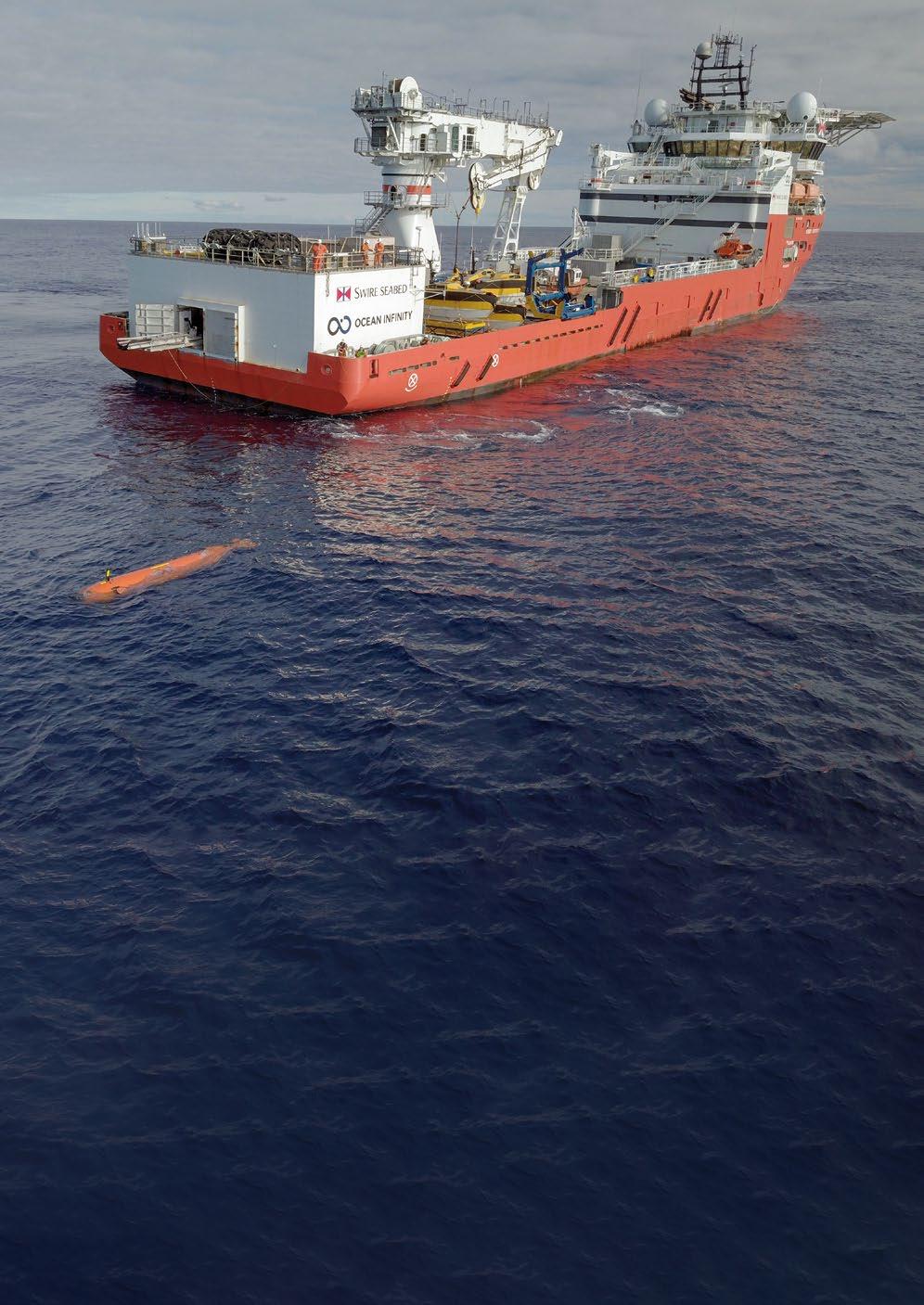
14 minute read
Finding USS Nevada
AUV Launch – Launching an AUV from an Ocean Infinity vessel. Capable of working in the deepest, darkest, and coldest reaches of the ocean, AUVs return to the surface with data that provides a detailed sense of what sonar and other sensors have revealed. (Photo courtesy of Ocean Infinity)
FINDING
Advertisement
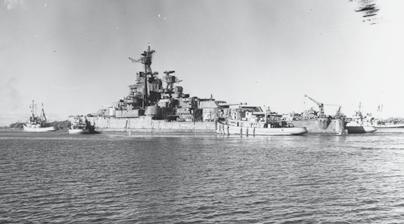
USS Nevada’s departure from Pearl Harbor under tow by the USS Jicarilla (ATF-104) on July 26, 1948. Bearing the scars of two atomic blasts, Nevada is about to be bombed and shelled by ships and aircraft for four days before sinking. (Official U.S. Navy Photograph, Naval History and Heritage Command)
USS NEVADA
OCEAN DISCOVERY AND REMOTE WORKING IN THE AGE OF THE PANDEMIC
SEARCH, Inc. and Ocean Infinity have announced the discovery of the USS Nevada (BB-36), one of the U.S.Navy’s longest serving battleships, viewed by some as the epitome of American resilience and perseverance. The USS Nevada was located 65 nautical miles southwest of Pearl Harbor, at a depth of over 15,400 feet. The discovery was the result of a successful collaboration between SEARCH and Ocean Infinity, and marks the combination of SEARCH’s leading mari time archaeological expertise, and Ocean Infinity’s unrivalled robotic technology and deep-water search capability.
AUV at sea. These unmanned robotic craft have revolutionized deep ocean survey and exploration. Ocean Infinity’s HUGIN AUV surveyed a hundred square mile area of the Pacific at a depth of nearly three miles to find the wreck of USS Nevada. (Photo courtesy of Ocean Infinity)
ting ready to sail, I said, “Oh, would you be interested?”. sified for years but have been declassified lately; there is hours later they said that they got a target. There is a debris Ordinarily, we would use satellite links, but this time – with
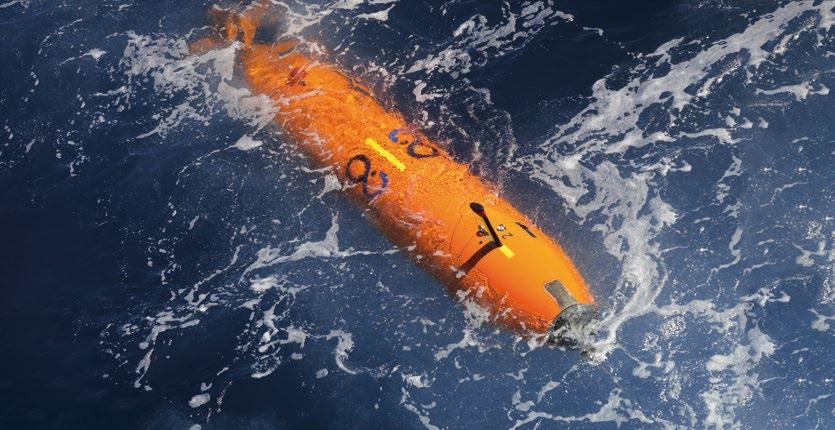
The mission was jointly co-ordinated between SEARCH’s operations centre and one of Ocean Infinity’s vessels, Pacific Constructor. It set sail for a range of commercial tasks in the Pa cific in early 2020, before the COVID-19 pandemic. As a result of the global health crisis, the ship has remained at sea on a range of tasks. ROV Planet Interviewed Dr. James Delgado to find out more about the discovery of this iconic ship.
RICHIE ENZMANN: Hi Jim. Great to have you here! Please tell us more about your organisation. What kind of work does SEARCH do?
DR. JAMES DELGADO: SEARCH is the largest underwa ter and terrestrial archaeology firm in the United States that does cultural resources work, including archaeological work on land and underwater. This also includes historical research, historical architecture, and museum services. SEARCH also has a branch that is helping to share archaeol ogy with the public, and we typically do that with partners like National Geographic. SEARCH was the principal adviser for the series ‘Drain The Oceans’ for example. The organisation works around the world, and many of our people have exten sive experience on projects, particularly in deep ocean work.
RE: How did the idea of the expedition for USS Nevada came about? What is the background to it? I would imagine that there are a lot of ships that you could have dived down to explore.
JD: I used to work for the National Oceanographic Atmos pheric Administration (NOAA), where I was the director of maritime heritage. There were a group of ships that were of interest to us. We are close to areas where there are na tional marine sanctuaries or monuments, as well as ships tied to significant events in history. Some of those were long standing projects or desires to go and find something. But working with my colleagues Michael Brennan and Michael Arbuthnot – we developed a list of 100 shipwrecks we would most like to find. So at the end of April we were in discussions on the phone with Ocean Infinity’s team… when we ended the conversa tion the question was asked, “Where are these ships today?” And when I was told that there was a ship in Honolulu, get Pam Orlando – who worked with me at NOAA – had pulled the original logbooks of the ships that sank Nevada, and I had the plots from these logbooks. They have been clas nothing secretive in them, just a matter of national security right after the War. Looking at that, Mike Brennan and I were able to draw up a 10-by-10-mile box for survey. Some people would say that this might not be a big box. If you consider that it has not been surveyed yet and was a hundred square nautical miles in three miles of water depth, then it becomes a bit more challenging, but not if you are Ocean Infinity. Their ships are good, their teams are very good, and their technology is exceptionally good. We sent over the informa tion and they deployed their two AUVs on the ship… about 24 field and then what looks to be a hull. And I said, “Great. When can we take a look?” And they said, “We have launched the ROV a couple of hours ago. It’s on its way.” So we all dialled in.
when I retired and joined SEARCH as Senior Vice President – everybody being at home – we all joined in using Microsoft Teams. Mike and I watched the dive with me as the archaeo logical lead while they dropped down to the maximum depth of 15,476 ft. to see Nevada for the first time.

RE: Were there any difficulties or challenges during the dive? It actually seems like a straightforward “job”.
1
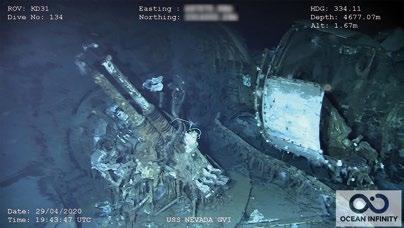
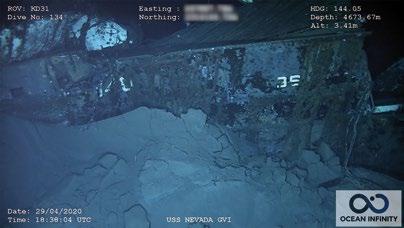
2
3
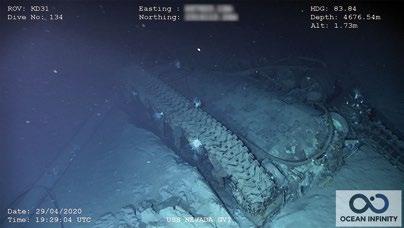
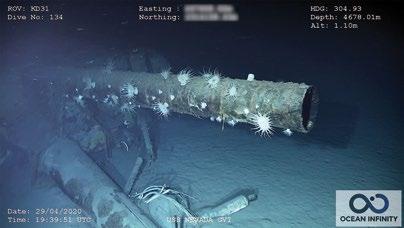
4
1
2
3
4 By the end of World War II, Nevada carried thirty-two 40mm Bofors antiaircraft guns. The airplane had changed naval warfare and guns like this helped the crew fight off enemy attacks from the air. This 40mm gun, still in its gun “tub,” is mounted next to a partly fallen, standard-issue Mark 51 “gun director” used by the crew to direct the fire of these guns. (Photo courtesy of Ocean Infinity/SEARCH, Inc.) The stern of the wreck has the remains of “36” and “140.” Nevada’s designation was BB-36 and the 140 was painted on the structural “rib” at the ship’s stern for the atomic tests to facilitate postblast damage reporting. (Photo courtesy of Ocean Infinity/SEARCH, Inc.) USS Nevada, like other ships at Bikini, was a floating platform for military equipment and instruments designed to see what the atomic bomb would do to them. One of four tanks placed on Nevada, this is either a Chaffee or Pershing tank that survived a 23-kiloton surface blast and a 20-kiloton underwater blast and remained on Nevada until the ship was sunk off Hawai’i on July 31, 1948. (Photo courtesy of Ocean Infinity/SEARCH, Inc.) Like its sister battleships of the World War I/(early) World War II-era, Nevada’s superstructure was built around a towering steel tripod mast that supported the navigation and command centers, lookout stations, and radar. This is the top of the mast that once towered more than a hundred feet over Nevada’s deck. (Photo courtesy of Ocean Infinity/SEARCH, Inc.)

JD: It was a very straight forward dive… Since I began my field in underwater archaeology, we practised hard to find wrecks using technology that has rapidly evolved. Visual surveys, to the introduction of side-scan sonars and mag netometers, to taking that technology and going to the extreme depths: it’s all happened quickly and within the span of my career. I remember being in Washington D.C. in the Government when Dr. Robert Ballard found the Titanic and recognising that it was a game changer. Following that we’ve not only to see the technology for finding, but for close-up charac terisation move forward. I made my first dive to Titanic in 2000. In 2010 I was chief scientist when we went back and mapped the entire site with two Remus AUVs, and then with a workhorse ROV. We used these to drop down and do very careful characterisation – precision visual mapping – to come up with what people saw in 2012: these amazing full scale colour images of Titanic, not just looking down or sideways, but giving people a 3D sense about the bow and the stern. There was also the view of this articulated piece of the hull, and some of the artifacts. Moving forward, working closely with Bob Ballard and others when I was at NOAA, I’ve seen that we could not only use that technology to go there, but through telepresence and with satellite links we’re able to bring people “with us” from all over. That was not just fellow archaeologists, but also ocean scientists. Nowadays what you might say is, “Okay, so what?”, but…they searched 100 square miles in 3 miles of wa ter depth, found the battleship, and then took a careful look at it within a few days. That would be the stuff of science fic tion just a few decades ago; now it’s science fact. And this is the way which we are going to increasingly con nect, not just with science, but to connect people to this final frontier which is the deep ocean. And an ocean largely unknown: 95% unexplored, and yet so vital not only to un derstanding our past, but also understanding what is happening now, and what the future of life on Earth might be. As far as we know, this is the first socially distanced deep ocean science mission with maritime heritage in the age of the pandemic, with a quarantined ship, a quarantined crew, and folks socially distanced working from home using Microsoft Teams. But what’s also important is that what I said earlier. It wasn’t just us with these kinds of systems: it’s others, other scientists. When we have done work in the Mediterranean, the Gulf of Mexico, the Atlantic, the Pacific, or elsewhere, we are simultaneously working side-by-side virtually with oceanographers, marine biologists of different specialties, ocean geographers, geologists, chemical and physical oceanographers, archaeologists, and historians who study every aspect of human history. All of that is made possible because you have a sophisticated ROV, with great instru mentation, hanging on to the end of a fibre optic tether, connected to a ship – being worked capably and brilliantly by the ship’s crew – and then to satellite connecting the
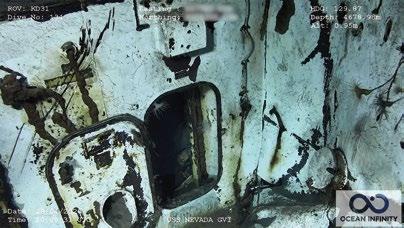
rest of us. Then when the switch is thrown, the entire world watches as we have done with some of these missions. Every time I’m on these ships I’ve always been struck by the
The engraving is on the exterior bulkhead above the hatch leading into a shell handling compartment for one of USS Nevada’s 5-inch/38 caliber guns. The first line of the inscription is the number of the door, the second is the designation of the compartment, and the third is the compartment number to which the door gives access. This remarkable level of preservation is occasionally found on deep-ocean shipwrecks due to the lack of light, oxygen, and the extreme cold at 15,400 feet down. (Photo courtesy of Ocean Infinity/SEARCH, Inc.)
elsewhere. Americans could rightly feel that the country was on the ropes. The next day the President of the United States stood up and while noting the attack was a day that would live in infamy, he also promised everybody an inevi table triumph. Nevada spoke to that: that human ability. Sometimes when… you have been knocked to the mat; you get up. You
incredible skill and knowledge of the ROV teams. They drive other struggles notwithstanding – the most prolonged pe for it, neither did Ocean Infinity. It was done because it was
them because they know them, because they designed them, built them, maintained them, because they are constantly modifying them. When we used a tethered system like the Argus Hercules system with Ballard at NOAA, with that dual system looking down where the other ROV is – that’s been in credible. Mike Arbuthnot, who worked with Jim Cameron used ROVs from the MIR submersibles to do dives into the Titanic to carefully survey and assess. And thanks to their work not only we have actual scenes from Titanic in Jim Cameron’s movie, but also a fair amount of data that documents what Titanic looks like and what levels of preservation are inside the hull. Referring to the work that we have done with our col leagues at Woods Hole with the deep submergence team, with the advanced imaging and visualisation lab: Bill Lange, Evan Kovacs, small ROVs that Evan has built has taken peo ple inside the fragile USS Arizona. We could still see uniforms hanging in closets, desks and other furniture in place, frozen in time from December 7th, 1941.
RE: So do you think that this is going to be the gold stand ard for marine archaeology in the future?
JD: I think what we are seeing going forward is groups like Ocean Infinity practising the gold standard. But I think it is going to continue to evolve into the platinum standard! The more work that is done, the more I think we will see im provements, the more we will see connections. And I think that the connections are important when it comes back to why USS Nevada… We were having a discussion about moving forward to the post-pandemic time when it comes, and we were also talk ing about the realities in this time, with people at home, and the concern that people had, the fear some people have. … The Nevada is an American ship, and it’s career spoke to not just what happened at Pearl Harbor but with how Americans respond to crisis. The attack on Pearl Harbor came as a stunning shock to many people. It seemed at the time with the near-destruc tion of the Pacific Fleet as the loss of the main battle line in Pearl Harbor… Japan were also opening the war in the Pacific with assaults in the Philippines, Wake, Guam, and
are resilient, you bounce back, maybe because you are stubborn. And so, with that I said let’s find Nevada to focus on that message.
We more or less knew where she was, but now was the time to pinpoint that… Let’s respectfully film it, and let’s share that not just with the United States, but with the world as a reminder; there have been dark times in our history, and yet we persevere. The response we have seen from the public and from other countries: the news spread internationally. Just the other day, the story was in the Washington Post. In the comments section, where there are always a few people that want to say less-than-nice things, many people said thank you. They were inspired by it and said it made the Memorial Day holiday extra important this year. It re minded people that this wasn’t just a weekend that went for three days and you had a day off to go to a BBQ, but be cause the freedom to do so has been secured in this country and in other countries by those who had shed their blood, sacrificed their youth, and their families who saw people never come home. There were also those who came home wounded…those sacrifices have given us – pandemics and riod of peace between major powers in the history of the modern world. So that is why we did it. We didn’t get paid With that I thought about the Nevada.
the right thing to do.

RE: That is quite an interesting parallel to make between the COVID-19 pandemic and Pearl Harbor. I can see the con nection there and where you are coming from.
JD: Well, human history does have a tendency to repeat it self. But with that, hopefully we will learn each time.
RE: What is going to be the next thing? Any more expedi tions and discoveries in your pipeline?
JD: Well, we’ve still got a list of 99 wrecks left. Having said that, sometimes discoveries are made that you are not looking for. For me and the rest of our team, and for our colleagues at Ocean Infinity, the quest is always there to make meaningful discoveries. We want to connect to the past as well as to the ocean frontier…it’s so vital to this planet, for our survival, and also a reminder that you never know what’s just around the corner.










